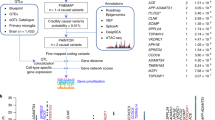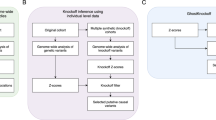ABSTRACT
In conjunction with the completion of the human genome sequence, microarray technology offers a complementary strategy to traditional methodologies used to search for genetic determinants involved in multifactorial diseases such as Alzheimer's disease. In order to gain benefits from this strategy, we have designed home-made microarrays to compare the expression of all ORFs located within loci of interest defined by genome scanning in Alzheimer family studies. Two approaches were selected using either probes amplified by PCR from a cDNA bank or specific oligonucleotides. Here, we report the challenging task of validating, prioritising and selecting the best ORFs derived from the genome sequence. The initial inventory from the NCBI website allowed us to select 5849 ORF's within nine loci. Half of them resulted from prediction models using the GenomeScan software. However, our data have shown that predicted ORFs may not be representative of exonic sequences, or even real genes. These observations have led us to exclude these ORFs from our study, decreasing their number from 5849 to 2748. Microarrays may be only ‘snapshots’ of our current knowledge of the human genome.
This is a preview of subscription content, access via your institution
Access options
Subscribe to this journal
Receive 6 print issues and online access
$259.00 per year
only $43.17 per issue
Buy this article
- Purchase on Springer Link
- Instant access to full article PDF
Prices may be subject to local taxes which are calculated during checkout


Similar content being viewed by others
Abbreviations
- ORF:
-
open reading frame
References
Loring JF, Wen X, Lee JM, Seilhamer J, Somogyi R . A gene expression profile of Alzheimer's disease. DNA Cell Biol 2001; 20: 683–695.
Lambert JC, Pasquier F, Cottel D, Frigard B, Amouyel P, Chartier-Harlin MC . A new polymorphism in the APOE promoter associated with the risk of developing Alzheimer's disease. Hum Mol Genet 1998; 7: 533–540.
Theuns J, Van Broeckhoven C . Transcriptional regulation of Alzheimer's disease genes: implications for susceptibility. Hum Mol Genet 2000; 9: 2383–2394.
Riazanskaia N, Lukiw WJ, Grigorenko A, Korovaitseva G, Dvoryanchikov G, Moliaka Y et al. Regulatory region variability in the human presenilin-2 (PSEN2) gene: potential contribution to the gene activity and risk for AD. Mol Psychiatry 2002; 7: 891–898.
Wavrant-De Vrieze F, Crook R, Holmans P, Kehoe P, Owen MJ, Williams J et al. Genetic variability in the amyloid-beta precursor protein locus may contribute to the risk of late-onset Alzheimer's disease. Neurosci Lett 1999; 269: 67–70.
Kehoe P, Wavrant-De Vrieze F, Crook R, Wu WS, Holmans P, Fenton I et al. A full genome scan for late onset Alzheimer's disease. Hum Mol Genet 1999; 8: 237–245.
Myers A, Wavrant De-Vrieze F, Holmans P, Hamshere M, Crook R, Compton D et al. Full genome screen for Alzheimer disease: stage II analysis. Am J Med Genet 2002; 114: 235–244.
Pericak-Vance MA, Grubber J, Bailey LR, Hedges D, West S, Santoro L et al. Identification of novel genes in late-onset Alzheimer's disease. Exp Gerontol 2000; 35: 1343–1352.
Olson JM, Goddard KA, Dudek DM . A second locus for very-late-onset Alzheimer disease: a genome scan reveals linkage to 20p and epistasis between 20p and the amyloid precursor protein region. Am J Hum Genet 2002; 71: 154–161.
Yeh RF, Lim LP, Burge CB . Computational inference of homologous gene structures in the human genome. Genome Res 2001; 11: 803–816.
Pruitt KD, Maglott DR . RefSeq and LocusLink: NCBI gene-centered resources. Nucleic Acids Res 1999; 29: 137–140.
Acknowledgements
We thank Dr Aline Meirhaeghe-Hurez and Dr David Mann for their helpful discussion. This work was supported by INSERM and the ‘Génopole de Lille’.
Author information
Authors and Affiliations
Corresponding author
Additional information
DUALITY OF INTEREST
None declared.
Rights and permissions
About this article
Cite this article
Lambert, JC., Testa, E., Cognat, V. et al. Relevance and limitations of public databases for microarray design: a critical approach to gene predictions. Pharmacogenomics J 3, 235–241 (2003). https://doi.org/10.1038/sj.tpj.6500184
Received:
Revised:
Accepted:
Published:
Issue Date:
DOI: https://doi.org/10.1038/sj.tpj.6500184
Keywords
This article is cited by
-
Evidence for induction of the ornithine transcarbamylase expression in Alzheimer's disease
Molecular Psychiatry (2009)
-
Transcriptomic and genetic studies identify IL-33 as a candidate gene for Alzheimer's disease
Molecular Psychiatry (2009)



